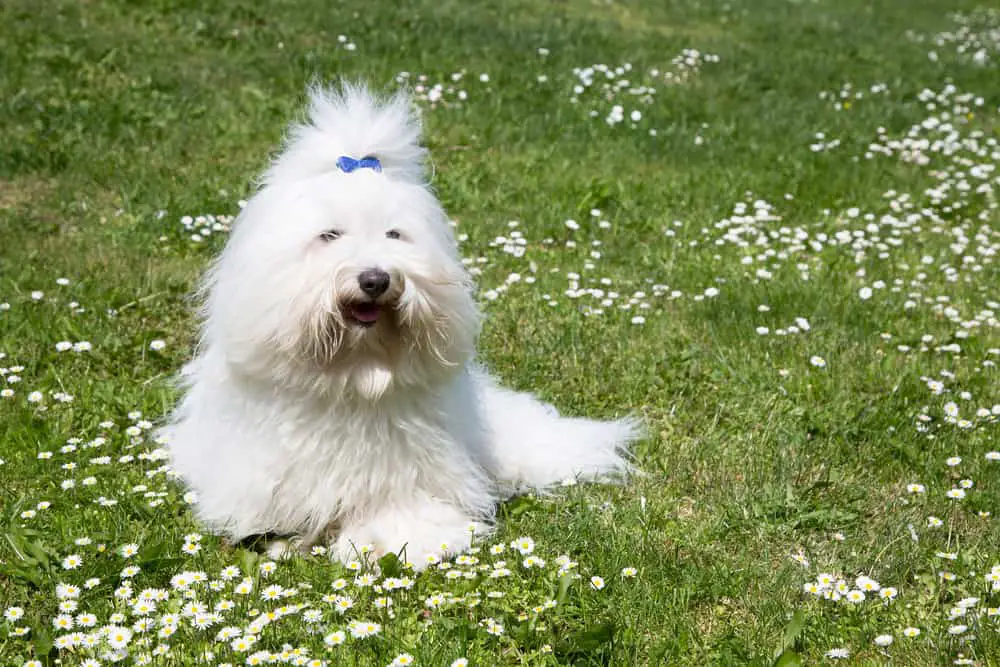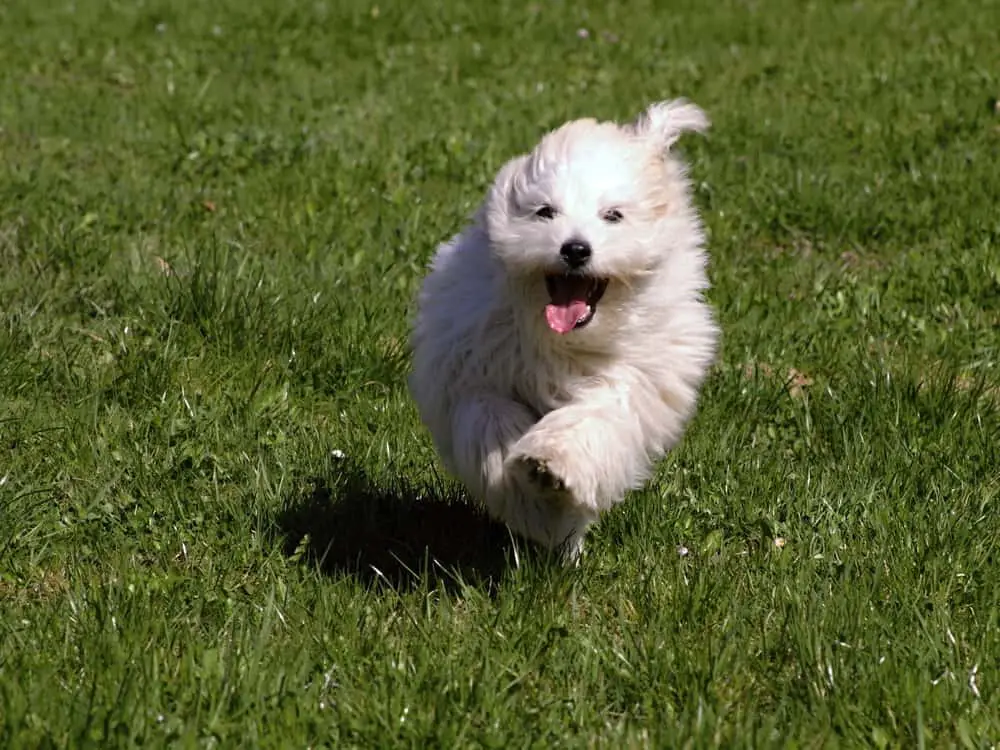Complete Guide To The Coton De Tulear: Grooming, Health, Feeding and More
As soft and cottony white as their name suggests, the Coton de Tulear is a lively lapdog with an intriguing history. Regal but never stuffy, the ‘Royal Dog of Madagascar” is a sprightly, down-to-earth aristocrat.
Despite being a relatively new breed, I’ve seen a handful of Cotons at my veterinary practice. They are wonderful little characters that certainly brighten their owner’s lives. This breed is bound to get more popular as more time goes by.

Table of Contents
How Big Does A Coton de Tulear Get?
| Height | Weight | |
| Male | 10″-11″ at the shoulder | 9-15 lbs |
| Female | 9″-10″ at the shoulder | 8-13 lbs |
What Does A Coton de Tulear Look Like?
At first glance, the Coton de Tulear resembles their close cousins — the Maltese and Bichon Frise. Similar in weight at 8-15 pounds, their arched back and long torso are distinguishing characteristics. They’re easily as adorable with their billowy coats and bright brown eyes.
Their triangular ears hang below the jawline, framing a square muzzle and noble chin — long tails are gently curved and carried over the back. All white is the preferred color, but light patches of gray or tan are permissible on the ears.
What Is The Personality of A Coton de Tulear?
Bred exclusively for companionship, the Coton de Tulear is a delightful, fun-loving addition to any home. Outgoing, they’re extraordinarily affectionate, remarkably engaging and always entertaining.
Cotons are playful, alert and highly responsive to training. Ideally sized for apartment living, they’ll thrive anywhere with enough attention but are ill-suited for spending long days alone. Excellent dogs for children and seniors, they need human company and a steady supply of affection — treat them like family, and they’ll reward you with steadfast devotion.
How Much Exercise Does A Coton de Tulear Need?
Cotons are active dogs that need a moderate amount of daily exercise, but they’re not fussy about their activities. Indoors or out, as long as they’re engaged, they’ll be content. Leisurely walks are always a good choice.
They love to chase, so backyard games, like fetch, bring out their frisky side. Cordial, they enjoy play dates with canine companions. Between outings, they’re clever enough to entertain themselves if you provide a wide variety of toys — ropes and puzzles are favorites.

How Much Grooming Does A Coton de Tulear Need?
Cotons have medium-to-long coats with a light cottony texture. They don’t shed much but need frequent brushing to stay clean.
Daily grooming with a rake removes debris and tames tangles before they become mats — use a metal comb that reaches down to the skin to tease out small knots. A spritz of detangling spray makes it easier and prevents damage to their hair.
Low-maintenance cuts are a popular alternative among busy owners. Choose from a range of styles from a 2-inch puppy cut to a short summer trim every 8-12 weeks. It’s a time saver and keeps them looking their best.
A bath is included with a professional grooming, or you can do it at home. White, they need more tub time than the average dog, so stick to mild, pH-balanced shampoos — harsh soaps can strip skin oils. Light conditioning smooths their coat and discourages matting without leaving a greasy residue.
What Kind of Dog Food Is Good For A Coton de Tulear?
Most small kibble dry dog foods will be suitable for a Coton. These little dogs have a pretty small mouth so large kibble will be a lot more difficult to chew.
Grain-free diets are a myth. Please do not feed your dog a grain-free diet unless there are specific food allergies that would benefit from a grain-free diet. Always consult your veterinarian before you decide to make any major diet changes.
Some good brands that I recommend include:
I usually tend to go with the bigger dog food companies because of the amount of time and money they have to research and test their products. They also have a stronger history of safe foods (very rarely will they have recalls) over the newer, more boutique-style dog foods.
It is important always to give your dog high-quality dog food. Monitor the number of treats and “people food” you give your dog to keep him healthy and fit. Keeping your dog at a healthy weight is the best and easiest way to extend the life of your Coton.
How Long Does A Coton de Tulear Live?
15-19 years based on information from the AKC, making it one of the longest-lived dog breeds
What Health Problems Can A Coton de Tulear Have?
As a small-breed dog, the Coton has the same risk of common health conditions including:
- Dental Disease
- Luxating Patella
- Obesity
Where Can I Find Out More About The Coton de Tulear?
United States of America Coton De Tulear Club (national club)
Where Can I Find A Coton de Tulear?
Breeder Directory from the national club
Looking for a Rescue? Keep an eye on this page maintained by the national breed club for any available rescues. The breed is still on the newer side so there’s likely not very many rescues available at any one time.
Interesting Facts About the Coton de Tulear
The Coton de Tulear is endearing but also rare and awareness of the breed is low.
Did you know?
• They May Have Walked the Plank
No one knows for sure how the Coton de Tulear ended up in Madagascar. They’re likely descendants of the Bichon Frise, so it’s surmised that they may have accompanied French travelers to the island or were bartered by merchants from afar.
Records, however, suggest the earliest inhabitants were feral pack dogs, so several theories have emerged to explain their presence. The most intriguing tale has them swimming to shore across the Malagasy channel from a wrecked pirate ship.
• Their Name is Meaningful
Coton de Tulear is a mouthful for Americans, but the name has meaning among the French-speaking people of Madagascar. “Coton” is the French word for cotton and an apt description of their coats. “Tulear” is the French spelling of the town where the breed is thought to have originated, Toliara.
• They’re Newly Recognized
The Coton is growing in popularity in the US, but few are familiar with the breed. Newly recognized by the American Kennel Club in 2014, the population is low and breeders are committed to producing high-quality dogs in keeping with the AKC standard. Responsible breed development is a slow process.
• Color Confusion
Different sources cite a range of standard colors for the Coton de Tulear. They’re not wrong, but it’s confusing for buyers. Thankfully, there’s a simple explanation.
The French Kennel Club was the first to recognize the Coton in 1970. Later, it was accepted by the UK Kennel Club and the International United Kennel Club. Each has a different breed standard, including color, and to date, the AKC recognizes only white.
